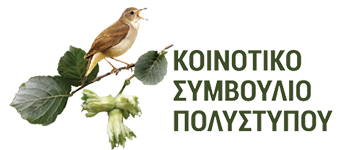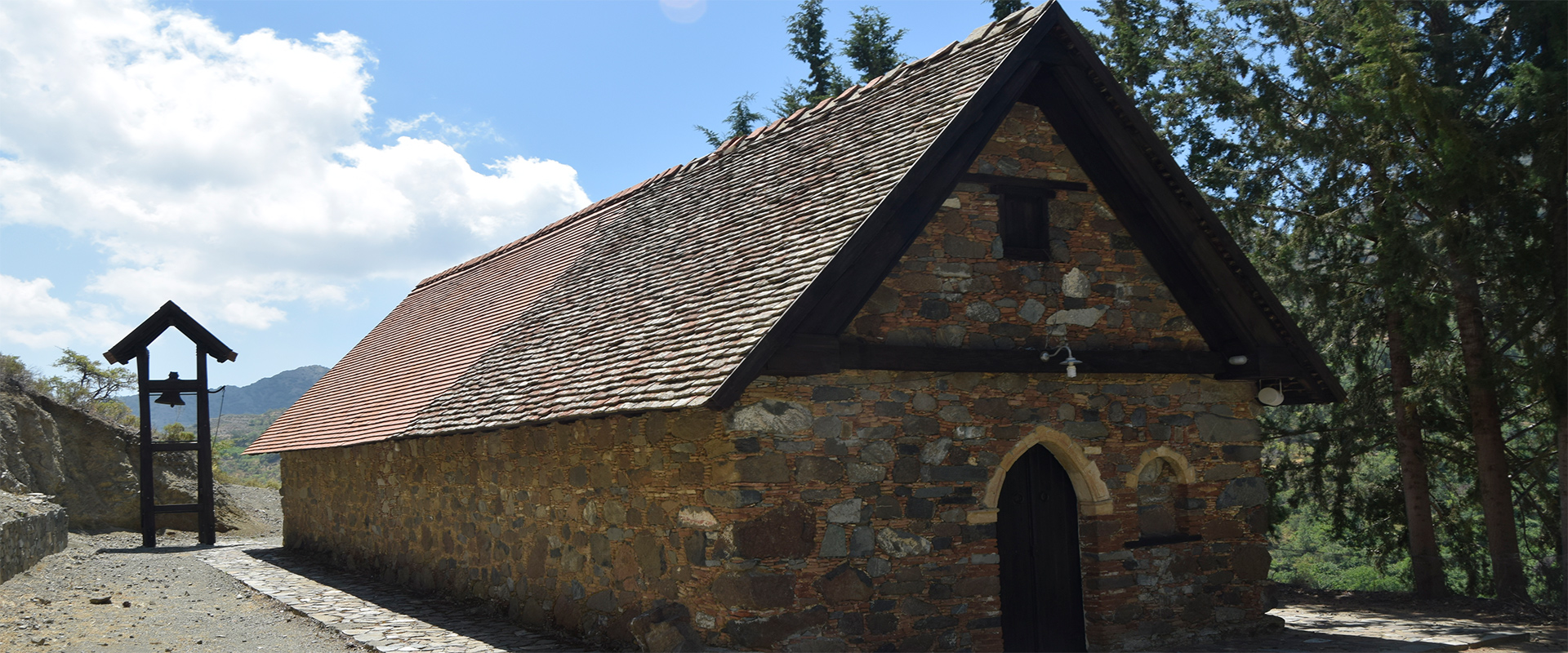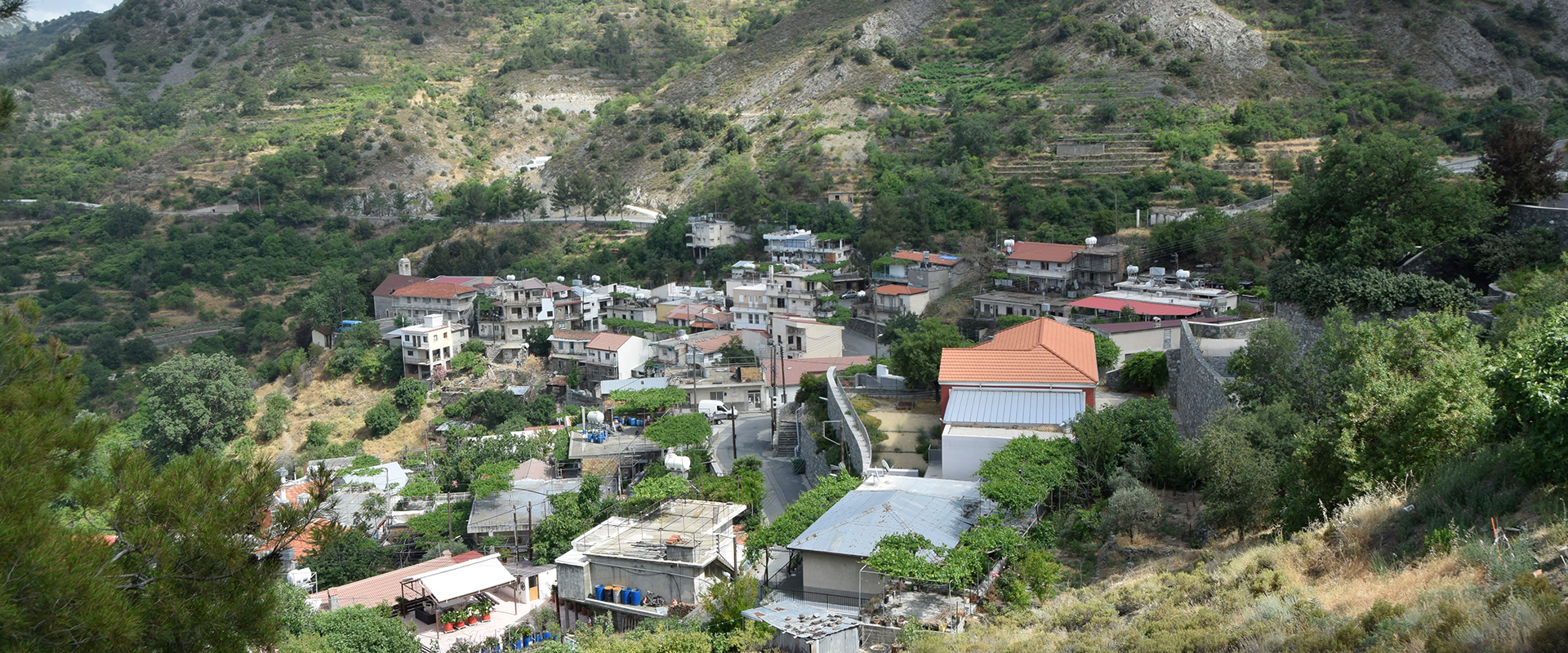Griva Digeni 9
Τhe Village
Tour
Entering the village either from Nicosia or from Limassol you will realize the unique graphic environment that characterizes every small community in the region of Pitsilia.
Narrow streets with houses built with stones that maintain the traditional architectural character (lower neighborhood), vine-arbors, flowers at the balconies, splendid almond trees that at the end of every February give a splendid banquet in white and pink colors. The houses that are found in the utmost ends of the village, extinguish slowly-slowly in the green valley of the hazel trees that every August give unique tastes while at the same time, the houses of the upper neighborhood succeed the pine trees that constitute a small forest.
However lets begin however from a concrete direction in order to have common points of report.
Coming from Nicosia you will first meet from all the chapel of Apostle Andreas. It cowardly pops up through the olive trees and the wild vegetation. Simple, small, concise and at the same time magnificent due to the fact that the real beauty is found in its simplicity. It was probably built during the 12th AC century always according to written and unwritten testimonies. It is a chapel that causes immense awe to the pilgrims as long as they enter with contrition its faintly lighted interior.
The amazing wooden engraved iconostasis with its important archaeological importance, certain small icons of saints, certain candles, few seats and the immortal Christian Spirit, embellish and decorate this small chapel that is dedicated to the first student of Jesus Christ, the Apostle Andreas. Time, which changes everything as it passes, did not make an exception in the case of this chapel. Around in 1869 the chapel presented some cracks, it was destroyed and built again with the same old architecture. In the older years, few monks were living there, functioning the church daily. Today it remains dumb even though it speaks with the birds, the wild flowers and the stars, but every 30th of November it opens festively its eyes and its hands in order to welcome its faithful people that with devotion run in order to pay their respect to the saint and his charm and exchange certain conversations with their protector. May his charm have you all in good health.
For conducted tours, you should take the key from the priest of the community, Papageorgio Xenofontos. (Tel.22652061)
As you proceed in the village, you will see two very old oak trees, a real natural beauty of the village and then the first houses are popping up (lower neighborhood). Here, it deserves to spend fifteen minutes for an impressive walk that combines nature and traditional architecture. In your right you will see small stone built houses, some of them devastated and abandoned and some other that are used up to today by few residents. Some of these houses have ovens and courtyard and 2-3 of them they have cauldrons for the distillation of “zivania”. The balconies are decorated with different flowers and at the left side of the street you will see the immense valley of Hazel trees unfolding like a green ocean, stealing impressions and looks.
In May, the concert of the nightingales begins and in August the harvest festival also. The walk in the old “popular” neighborhood of the community finishes at “Vrysi”. A beautiful tap that throughout the year gives to the visitors or to the tired farmers its cool water that springs from the natural sources of the region.
Going up, you can walk in the beautiful narrow streets, enjoy the beautiful vine-arbors in the streets, the balconies with the flowers, the landords cleaning their houses and if you are lucky during the period of Autumn, you will admire them making “palouze” and “soutzoukko” immediately afterwards the festival of vintage where they all collect the grapes from their vines.
Make a stop at Stavroullas’ cafe for a coffee and continue your ascendant course up to the crossroad of the village.
At your left you will find the church of Agios Nicolaos that functions during the weekends and during big feasts.
Going straight you will reach the Krya Vrysi (tap) that is found hidden in the hazel trees. Do not hesitate to drink its splendid water.
If you continue walking in a straight way for about 15 minutes, you will enjoy a course having different sorts of trees –hazel trees, almond trees, apple trees, walnut trees and you will reach the Community Park “Laouda”, where you will see something impressive. A panoramic view of Polystipos that looks like an amphitheater.
For romantic people, this walk during the evening leads to a banquet of light, due to the fact that Polystipos and the magic stars carry away the observer.
Next to the community center it is found the monument with the statues of the heroes of the EOKA Fight 1955-59 against the English troops, Christos Tsiartas and Andrea Panayiotou.
Returning back to the crossroad and taking the right street from where we began before, you can see the other neighborhoods of the community. It deserves to go up the stone steps that lead to the area of the Municipal School and observe this beautiful building that was built during the English domination. Today it remains closed and recalls the old seasons before urbanism affected the life of the countryside.
A beautiful small pine tree forest starts where the last houses of the upper neighborhood finish.
If this tour made you fill tired and also hungry, make a click to the next page (“SERVICES”) for the “menu”.
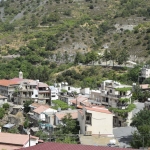
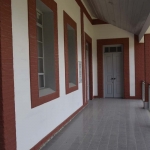
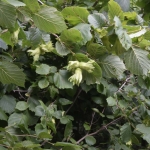
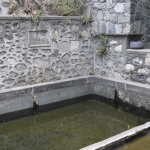
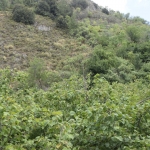
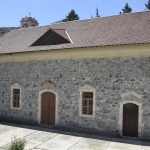
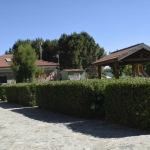
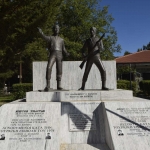
History
Because all the destinations are not the same…
We live in a unique place, dowered from nature, worked by people centuries ago.
A landscape that cuts your breath, a nature hard and simultaneously generous to people, a nature that speaks more clearly than people… dangerous mountains, full of stones, a wild and imposing landscape.
Here nature and people are joined together, here anyone finds the secret bonds with life, here anyone “speaks” more easily with God.
The village of Polystipos has the privilege to be included among the villages of Cyprus having the highest altitude since it is built at an altitude of 1150 meters and simultaneously has the “privilege” to be one of the smallest villages of the province of Nicosia since it is the third smaller one in administrative extent having an area of 239 hectares.
The name Polystipos is complex and implies a locality with many “stipes” that is to say plants of vine. Consequently Polystipos means a locality with a lot of vines. In the old years the region of the village was full of vines which were decreased considerably during the 18th century (the period of the Ottoman domination), because most of them were abandoned after a special taxation that was imposed in the production of wine and it was judged as disadvantageous.
The precise date of the foundation of the village is unknown and the various researchers have not reached a final conclusion. However it is considered sure that the village existed since the medieval years.
A foreigner sightseer, Nte Mas Latri, reports it as “Polistipia” and includes it between the royal properties of the Franks domination period.
Older researchers supported that Polystipos was initially named Apostle Andreas, because in medieval documents is reported in the region, a village with this name. This opinion is supported also by a map of 1573 of the great Dutch cartographer Abraham Ortelius that marked a settlement with the name “Apostle Andreas Polystipos”. In handwritten documents of the museum, Polystipos is reported in the mountainous villages of Saint Rinc.
Important information for the villages of Cyprus and the various names of the regions is taken from the handwritten document Leimonida. In this handwritten document, the villages of the Venetian domination period are reported and are separated in Casali or Prasti according to the number of their residents. In the handwritten Leimonida, Polystipos is reported as Casali of the province “Pentagia”. It should be clarified, that afterwards Great Constantine and during the entire Byzantine period, Cyprus was divided into 14 provinces or regions. One of these provinces was “Pentagia” or “Solea”, in which Polystipos was belonging to. This subdivision of Cyprus was maintained up to the years of the “Luzinians” that divided Cyprus into 12 provinces.
The skepticism that prevails regarding the name but also the season of the foundation of the village is supported also by a name that is reported by the older residents of the village and is connected with tradition. It is the name “Avlonitis” that is still being used by the old men in order to declare a locality near the monastery of Apostle Andreas.
The two prevailing theories regarding the names are:
1st Theory:
The word Polystipos initially constituted a surname of the monastery of Apostle Andrea, from the name “Apostle Andreas the Polystipos” and later constituted the name of settlement that was founded near the monastery. This theory is explained satisfactorily:
1. The existence in the maps of a settlement reported as Saint Andreas and
2. The existence in the Venetian lists of a village named “Apostle Andreas the Polystipos”.
This theory is the most acceptable one between the researchers and certain accept the existence of only one village, overlooking somehow the popular tradition that states a village with the name “Avlonitis”.
2nd Theory:
This theory takes into serious consideration the name “Avlonitis” and speaks for the abandonment of a settlement and the creation of some other or the conjunction of two settlements with the locomotion of the one to the other.
The abandonment of a settlement during the period of the Ottoman domination was a usual phenomenon, due to the fact that from the 850 villages of Cyprus that were reported during the Franks domination, only 600 villages are reported from the beginning of the Ottoman domination and then. They were abandoned more than 200 villages. The reasons for the abandonment of a settlement were mainly the contagious illnesses or the lack of water and cultivable ground, but also the insecurity due to the various raids that forced people to move to safer areas.
This theory therefore accepts the abandonment of a settlement (that was near to the church of Apostle Andreas) and the creation of some other at a near distance (in the locality that is built now the village of Polystipos), without of course excluding the fact that two settlements existed and the residents of the one abandoned their settlement and were installed in the other that already existed.
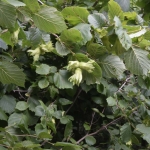
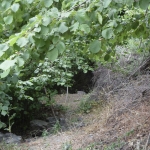
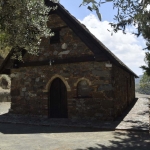
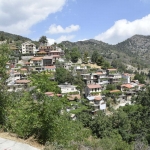
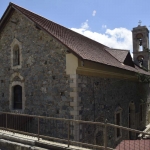
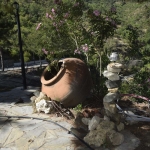
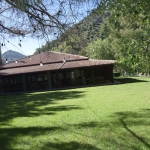
Heroes Monument
Leaving Polystipos and heading towards Alona, rests PANTHEON Community Park near “Laouda” area. The park attracts many visitors as it overlooks Polystipos with its small houses built amphitheatrically on the slopes covered in vineyards as well as the forest areas surrounding the village, the green vineyards and the fields with almond trees. The visitor can also see the melancholic mountain of Pentadaktylos, the yellow field and they Cypriot capital.
The name Pantheon is in this case justified, as one can see and enjoy everything from this point. Enjoy the green view, the singing of the nightingale, of the “rustle” of the running water in the creeks of the valleys cultivated with fruit-bearing trees.
Here, next to the playground, the love of the people of Polystipos and of the expatriates’ has helped build a monument to honor two heroes from Polystipos that died during the Liberation Struggle 1955-1959, namely Christos Tsiartas and Andreas Panayiotou. This monument was built to honor them since they gave their lives, their most precious asset for Freedom. The statues of the two men that are the main part of the monument send out the message to all visitors that there are immortal values worth fighting for, for all Greeks that are responsible and honorable citizens, such as Freedom and dignity to offer ones life is necessary for the protection of these ideals.
The love of Polystipos inhabitants and expatriates’ towards our missing persons of 1974 and their families has us all waiting for 33 years to learn about what happened to our four missing lads.
Andreas Argyrou, Panayiotis Pavlou, Loizos Sokratous and Renos Ch. Hadjiloizou.
Polystipos anticipates hearing news about the four young men from the Investigation Committee, so as to honor them accordingly for their sacrifice, for their will to fight against the Turks for their country in 1974. Next to the heroic figures of 1955-1959 another holy monument will stand, the monument honoring the 4 men from Polystipos that have been missing since 1974, sending out the exact same message that: “Freedom requires virtue and boldness”.
P.S: The monument honoring Christos Tsiartas and Andreas Panayiotou was built in 1993 by the Expartiates’ Association of Polystipos. The statues were created by the Cypriot artist A. Savvides.
The revelation of the monument was made by the former president of the Republic of Cyprus, Mr. Glafkos Klerides in September 1997.
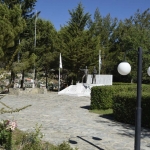
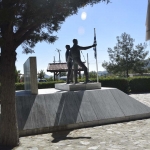
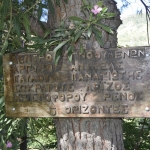
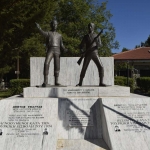
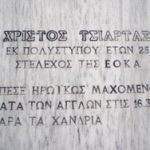
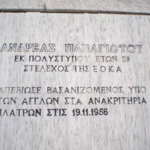
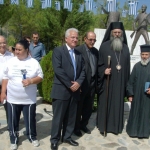
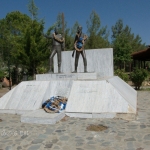
Services
A. Food
If your journey in beautiful Polystipos has made you hungry, then you can enjoy the traditional Cypriot cuisine.
At “PANTHEON” restaurant, situated within the Community Park near “Laouda” area, next to the road leading to the neighboring village of Alona, and that operates on weekends and weekly during July and August, the visitor can enjoy a coffee or a great lunch with local or Cypriot traditional dishes. Here you will experience the real local wines of Polystipos and the local meze. What is most appealing are the local chiromeri, lountza, sausages and many more. Mrs Sonia and Mrs Ourania are waiting for you and will make you feel right at home (Tel. no. 22652502, 99310626)
ENJOY
You can also enjoy a coffee, a refreshment drink or a beer at Mrs. Stavroullas coffee-shop named “Dasaki”, as well as traditional treats such as walnut sweets are offered. What is more, enjoy the view from a lovely place decorated with hortensias. You can also discuss several topics with locals having their coffee and have great discussion in a great and warm atmosphere.
It would be an omission not to mention that on weekends you can taste loukoumades with Cypriot or Greek ouzo and genuine “mahalepi” at “Klimataria” restaurant, owned by Mr. Phedias Polydorou, especially during summer.
Additionally, you can have a coffee and play backgammon or cards at the small coffee-shop owned by Mr. Stavros or at the Club-house of the Sports’ Association.
B. Accomodation
If you wish to stay overnight, you can rent a room at:
Evridikis house (tel.no. 99557643, 22377569, 22750509 fax.22771605)
Dryades, Andreas Asmenis Tel. no. 357-24623310, 357-99659539, Fax. 357-24658967
Website (http://www.geocities.com/polystypos)
C. Markets
When leaving, do not forget to take home made treats, wine, zivania, shioushiouko, palouze, dried figs and raisins, nuts (hazelnuts, almonds, walnuts), fresh eggs and delicatessen from Mr. Andreas Polydorou (tel.no. 22652074) and Mr. Kostakis Kyriacides (99462850), as well as fresh bread from Mrs.Yiorgoulla (tel. no. 22652124)
Cultural Center
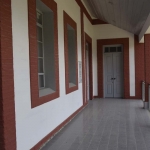
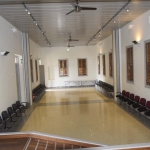
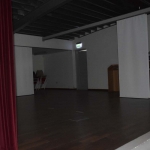
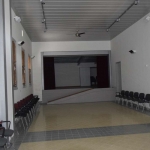
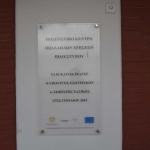
Agrotourism
